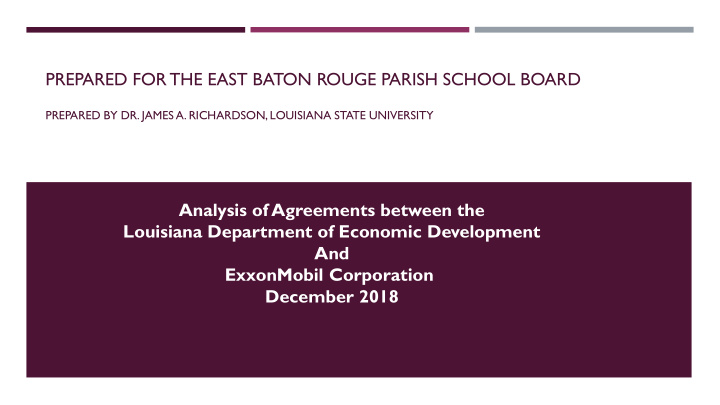



PREPARED FOR THE EAST BATON ROUGE PARISH SCHOOL BOARD PREPARED BY DR. JAMES A. RICHARDSON, LOUISIANA STATE UNIVERSITY Analysis of Agreements between the Louisiana Department of Economic Development And ExxonMobil Corporation December 2018
LOUISIANA INDUSTRIAL TAX EXEMPTION PROGRAM (ITEP) Policies Associated with ITEP Use of ITEP as Competitive Incentive for Job Creation and under compelling circumstances job retention Involvement of local parish, municipal, school boards, and sheriffs with respect to the extent and conditions of ITEP Statement of return on investment as determined by the Secretary of LED
LOUISIANA INDUSTRIAL TAX EXEMPTION PROGRAM (ITEP) Agreement Between LED and XOM (Polyolefins Plant) Agreement Between LED and XOM (Ultra-Low Sulfur Mogas Project) XOM to spend $742,801 on machinery and equipment and $2,228,4904 on labor and engineering Estimated Investment of $64.342 million to expand motor gasoline production capacity with $36.401 million on machinery and Project creates no new jobs but retains 244 existing jobs with equipment payroll of $25,620,000 or $105,000 per worker Labor and engineering costs to be $109.202 million Creation of 45 net new jobs with payroll of $4,725,000 18 net new jobs with payroll of $1,890,000 or $105,000 per job Construction and/or Installation completed 12/31/2017 Construction and/or Installation completed 12/31/2017 T o upgrade nitrogen transfer systems components and improvements to position site for future capital projects Support Baton Rouge ExxonMobil Refinery to maintain role as 4 th largest refinery in the United States Secretary of LED projects return on investment to State and Local Governmental Entities will exceed benefit of Exemption focusing on Secretary of LED projects return on investment to State and Local multitude of factors including capital expenditures, direct payroll tax Governmental Entities will exceed benefit of Exemption focusing on receipts, indirect payroll tax receipts, and other indirect tax receipts multitude of factors including capital expenditures, direct payroll tax receipts, indirect payroll tax receipts, and other indirect tax receipts
Local Taxes Collected Due to XOM Investment and the Ad Valorem Taxes Foregone (Investment by Local Governments) XOM (Mogas) EBRPSS Share of Net New Taxes and ITEP XOM (Polyolefins Plant) Tax Collections and ITEP for EBRPSS $1,200,000 $90,000 $80,000 $1,000,000 $70,000 $800,000 $60,000 $50,000 $600,000 $40,000 $30,000 $400,000 $20,000 $200,000 $10,000 $0 $0 Net New Tax Receipts ITEP Net New Tax Receipts ITEP
COMPARING NET NEW EBRPSS TAX RECEIPTS TO TAXES FOREGONE DUE TO INDUSTRIAL TAX EXEMPTION PROGRAM XOM (Mogas) XOM (Polyolefins Plant) Benefit-Cost Analysis from 2018 through 2037 (20 Years of Production 1.6349 1.4218 at facility) Benefit-Cost Analysis from 2018 through 2027 (the ending date of the 0.9592 1.0788 tax abatement program)
Comparing the Net New Tax Receipts as a Present Value Compared to Present Value of Taxes Foregone Local Government Entities in East Baton Rouge Parish School East Baton Rouge System Benefit-Cost Analysis from 2019 through 2041 (20 Years of 1.8771 1.7903 Production at facility) Benefit-Cost Analysis from 2019 through 2031 (the ending date 1.2516 1.1848 of the tax abatement program)
CONCLUDING REMARKS Several caveats about Benefit-Cost Estimates If ITEP is the tipping point, then a Benefit-Cost Estimate of less than 1.0 may be a good deal. You may not get, as an Local governments, just like the state, want to see their example, $2.5 million in ad valorem taxes over ten years, but you economies grow. sacrifice the $2.0 million you would get from a variety of taxes. Large investments by major firms, along with the ongoing Math is 50% of something is better than 100% of nothing production, provide overall support for this growth. But limits to this saying as well: an industry may impose Local governments, just like state governments, have to be costs on local governments which must then be aware of the market place in attracting major investments to compared to the revenues that they will generate their communities. If the company will make the investment without ITEP , Benefit-cost ratios provide information to the local but obviously will apply for it if available, then the local governments regarding the return on their investment in governments ends up with a Benefit-Cost Estimate of 0 granting tax abatement options to companies considering major since the company would have made all of the investment investments in a community. without any incentive. The issue now becomes: is ITEP a long-term tax incentive that will keep an industry or company consistently interested in EBR as a place to do business
PREPARED FOR THE EAST BATON ROUGE PARISH SCHOOL BOARD PREPARED BY DR. JAMES A. RICHARDSON, LOUISIANA STATE UNIVERSITY Analysis of Agreements between the Louisiana Department of Economic Development And ExxonMobil Corporation December 2018
Recommend
More recommend